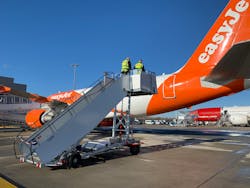Go the Next Level with Electric-Powered Passenger Stairs
Aircraft stairs are a vital piece of equipment not only for passengers but also for maintenance crews. TBD, which specializes in ground support equipment (GSE) and access solutions for the aviation industry, has developed Electric-Powered Passenger Stairs designed to meet the latest Airport Handling Manual (AHM) regulations.
Jonathan Attfield, sales director at TBD, says the creation of the product came from a desire of airlines and operators to reduce carbon emissions and reduce reliance on fossil fuels while maximizing speed and efficiency airside.
“All powered stairs are supplied with top platform operation and fully compliant anti-collision features,” Attfield says. “These provide the safest driving position for the operator and the aircraft, thus ensuring the fastest and safest aircraft turnarounds.”
All stairs in this product line have a fully galvanized structure that offer a robust hard-wearing product to ensure low-through-life costs.
TBD has been creating ground handling equipment for decades. It specializes in creating equipment that can be used in harsh environments with high-grade corrosion-resistant materials that are hand built or robotically welded to very high standards and tolerances to oppose fatigue from all working conditions.
Although TBD’s Electric-Powered Passenger Stairs have been manufactured for only one year, they are already receiving positive feedback from customers utilizing the equipment.
“One major airline is noting a significant reduction in turnaround time and 100-percent reduction in aircraft impact damage,” Attfield notes. “These two aspects alone are extremely important to airlines as they represent huge potential cost savings for the operation.”
The TBD Electric-Powered Passenger Stairs are currently being used by ground handlers and airlines in the United Kingdom, across Europe and North Africa.
Attfield says TBD can provide stairs to suit any aircraft fleet, including Airbus and Boeing fleets along with Embraer models and many military aircraft. The most popular choice for the electric-drive stairs is the TPS2435 model.
“This services the single aisle A320/B737 fleets of many carriers whose business models require fast turnarounds while still ensuring maximum safety,” Attfield explains.
The electric-drive system can be installed on any passenger or crew stair in the TBD range.
TBD offers three different versions of parallelogram stairs. Attfield notes that the offerings cover sill heights from 1.9 to 4.5 meters and a telescopic version offering coverage from 2.5 to 5.5 meters.
“TBD continually develops products to ensure compliance and optimize customers’ complex and evolving operational needs,” Attfield says.
There are multiple key features to the Electric-Powered Passenger Stairs that are available, regardless of the type of drive chosen.
“The main advantage to the electric stair is the ability to operate without the need for diesel or petrol,” Attfield says. “However, TBD’s range of powered passenger stairs features many other advantages, such as: AHM-compliant anti-collision and top platform driving piston, including height control.”
The stairs are fitted with AHM913-compliant, full-speed control technology, which automatically reduces the speed on approach and stops before contact is made to aircraft.
There are also optional features available for the Electric-Powered Passenger Stairs. Attfield says solar charging is a key option to provide the operator with a complete self-sufficient product. Customers can also specify if they want corporate colors and branding.
Being in certain geographic locations, with certain climate conditions and traffic volumes, can influence the use of the Electric-Powered Passenger Stairs significantly.
“Ideally, the airport infrastructure will be capable of providing charge points on the stand. TBD’s solar charging option can ensure operation without charge points. However, this isn’t completely reliable at all times of the day and in all geographic regions,” Attfield says.
Regular inspections and maintenance are critical to keeping the equipment up-to-date and secure.
“All TBD products are provided with strict guidance on all maintenance procedures needed throughout the life of the product,” Attfield says. “TBD engineers also give direct training to maintenance providers on site.”
About the Author
Eavan McGrath
Assistant Editor
Eavan McGrath originates from northern Illinois and is a graduate of UW-Whitewater. There she studied professional writing and publishing, creative writing and marketing. Eavan began her career with an internship in healthcare, developing marketing skills, writing and communications skills as the internal and external communications intern for the immunology and oncology team for AbbVie. She moved on to developing media content for a landscaping company called James Martin Associates, writing blogs and social media content as the creative content writing intern. Here she plans to continue advancing her skills in writing, marketing and editing as an assistant editor with the Endeavor Aviation Group.

